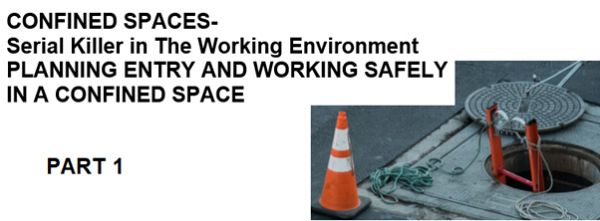
Tuesday March 1, 2022 08:40
Understanding and Identifying the Hazards & Assessing the Risks Associated with Confined Spaces.
We examine in this 2-part series one of the least recognized hazards in many workplaces yet one of the deadliest.
WorkSafe New Zealand accepts the Standard AS 2865 Confined Spaces as the current state of knowledge on confined space work entry.
Confined spaces- the Serial Killer:
Confined spaces have been likened to a serial killer. Year after year, people die when entering confined spaces to carry out work. In some cases, multiple fatalities occur when would-be rescuers enter the space and become victims themselves.
Consider these cases in New Zealand:
- A man was killed when he was engulfed in a silo containing sand.
- Two men were hospitalized after inhaling hydrogen sulphide. One man was cleaning inside a tank that previously stored a substance for cultivating mushrooms. When he lost consciousness, the second man climbed in to rescue him before also losing consciousness.
- Three men died from lack of oxygen inside a sewer
- A man drowned in slurry after being suffocated by fermentation fumes in a tank used to mash pig feed.
- Gases from fermenting wine suffocated a winemaker inspecting a vat.
- A man steam cleaning the inside of a fuel tank died from lack of oxygen.
The most common cause of death is lack of oxygen. Inspection, cleaning and maintenance accounts for the most incidents. The majority of fatalities have been would-be rescuers.
Confined space work is covered by an Australian standard: AS 2865 Confined spaces. This guide will give you a brief overview of the requirements and procedures in the standard. It is not a substitute for the standard itself.
Anyone who carries out confined space work needs to be familiar with the standard and should have specialist training as well.
Safety ‘n Action have specific training courses on entering and working in confined spaces that are recognized by New Zealand Qualification Authority and credited to applicable NZ unit standards.
What is a confined space?
A confined space is an enclosed or partially enclosed space. It is not intended or primarily designed for human occupancy and may present a risk from one or more of the following at any time:
- Unsafe concentration of harmful airborne contaminants
- Unsafe concentration of flammable substances
- Unsafe levels of oxygen
- Substances that can cause engulfment.
Examples include storage tanks, tank cars, process vessels, ovens, boilers, silos, pits, pipes, sewers, shafts, ducts and shipboard spaces.
What does the standard require?
The standard follows the approach of the Health and Safety at Work Act 2015 (HSWA). It requires persons conducting a business or undertaking (PCBUs) to:
- Identify the hazards associated with working in the confined space and conduct a risk assessment
- Control the risks posed by the hazards by elimination
- Minimise the risk if elimination isn’t reasonably practicable.
Identifying hazards and assessing risk:
The standard gives detailed information on hazard identification and risk assessment.
Some of the hazards of confined spaces include:
- Oxygen-deficient atmospheres, which can cause unconsciousness, brain damage and death. Oxygen deficiency can be caused by rust, fire, absorption by grain or soils, consumption by bacteria, or displacement by another gas.
- Toxic atmospheres, containing gases, vapours, dusts or fumes that have poisonous effects on the body. Cleaning, painting or welding may produce dangerous vapours and fumes.
- Flammable or explosive atmospheres, containing flammable gases, vapours or dusts which could be ignited by a spark or open flame.
- Engulfment – workers can be trapped or buried by bulk materials such as grain, sand, flour, fertilizer and sawdust.
- Operation of moving parts (e.g., being trapped or crushed by augers, mixers, agitators or conveyor belts).
Controlling the risks:
The control measures should be applied in the order given earlier (beginning with elimination, followed by minimization). Consider the following issues:
- Can work be done without entry to the confined space? Always, as a first step, check to see if the work can be done with equipment from outside the confined space. The golden rule is: Don’t go in if you don’t have to.
- Isolate contaminants and moving parts
- Clean and purge the confined space if necessary
- Use a suitable cleaning method to remove harmful solids or sludges. Purge with fresh air to remove harmful gases or vapours.
- Warning: Never use oxygen to purge a confined space: this can create a fire and explosion hazard.
- Test the atmosphere for oxygen
- Use a suitable detector to determine whether the confined space contains a safe oxygen level for breathing.
- Test the atmosphere for toxic and flammable contaminants
- Test for toxic contaminants (e.g., hydrogen sulphide, methane, carbon monoxide) and flammable contaminants (e.g., petroleum vapours).
- You need to use appropriate detection equipment, which should be correctly calibrated at regular intervals.
- Then test again for levels of oxygen and other gases to ensure that contaminants are reduced to below the Workplace Exposure Standard, or a safe level.
- Use of gas detectors should be only by a suitably trained person.
Your Securo consultant is available to help and assist you, so please give them a call or alternatively, you can contact Securo head office on 0800 55 33 44.
Next month – Part 2 – Entering the confined space.
Our updated Covid-19 Emergency Response Manual reflecting Omicron response guidelines is now available to download from our online service.



